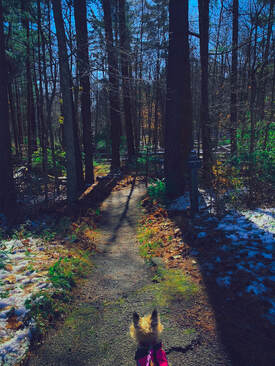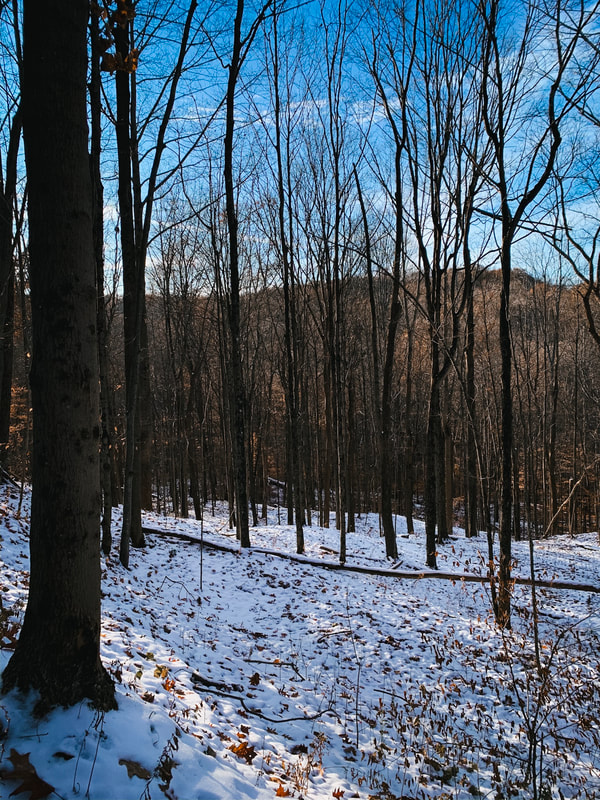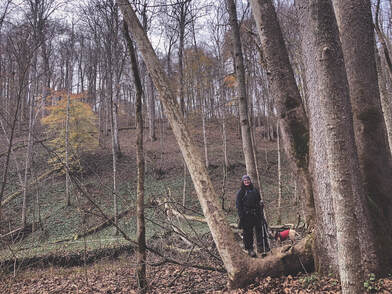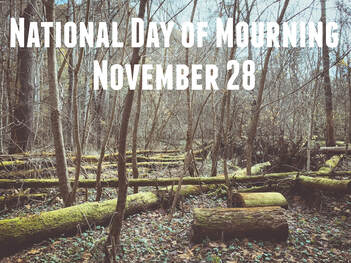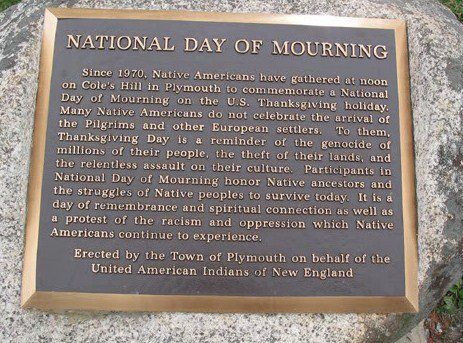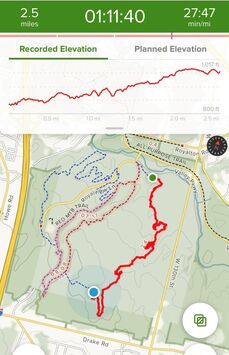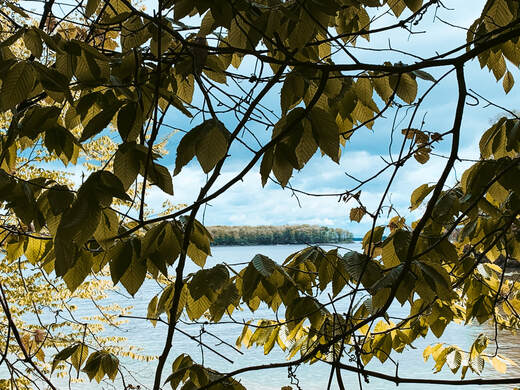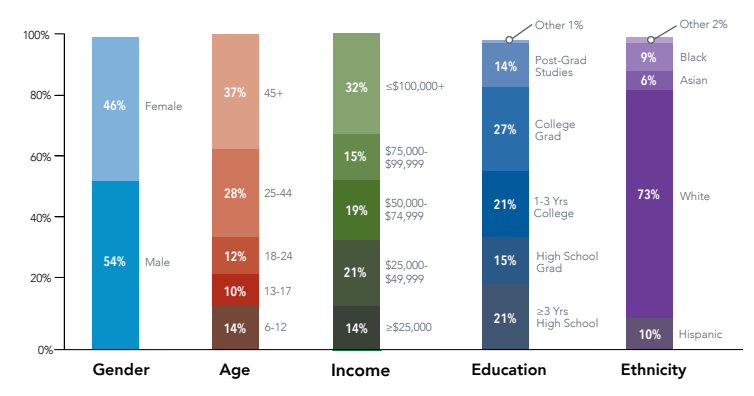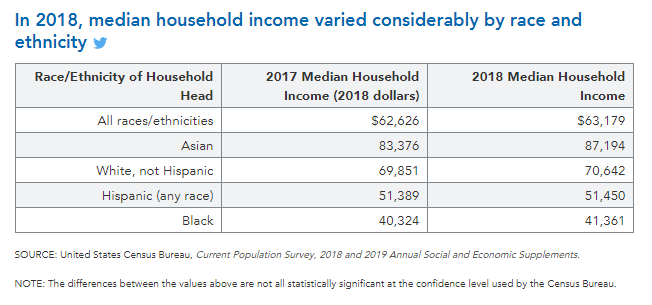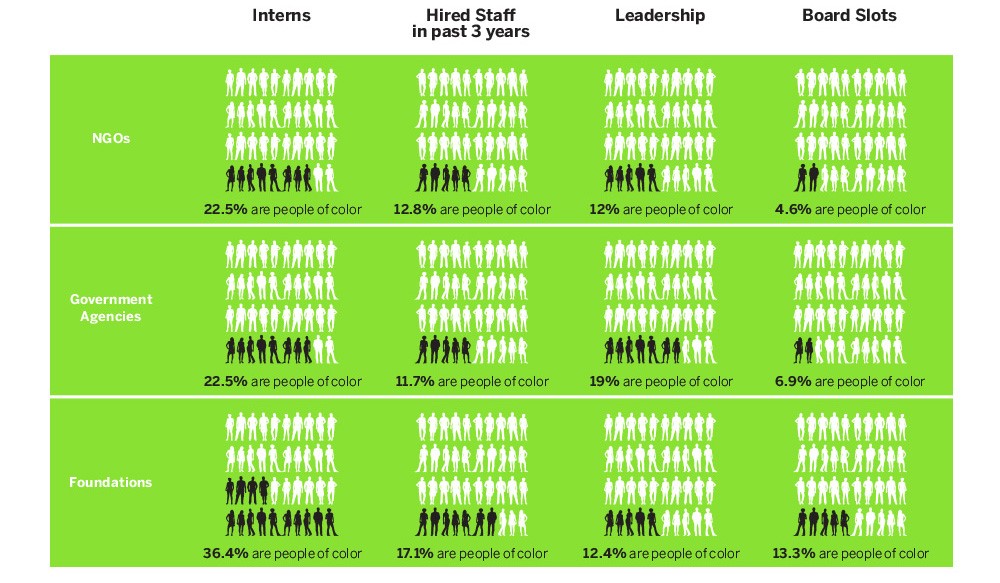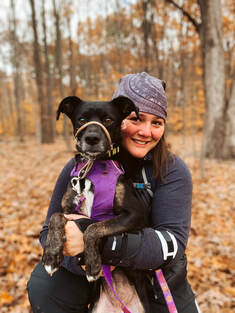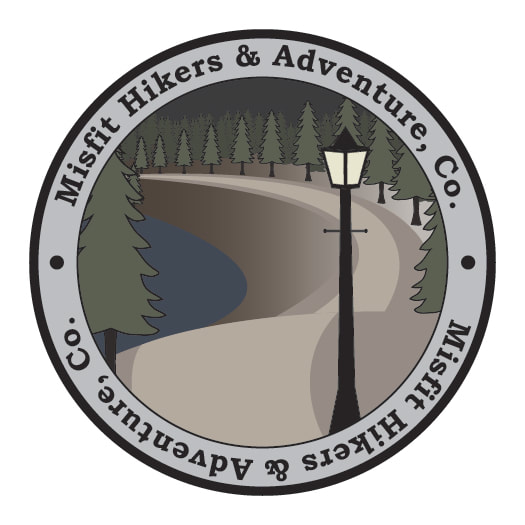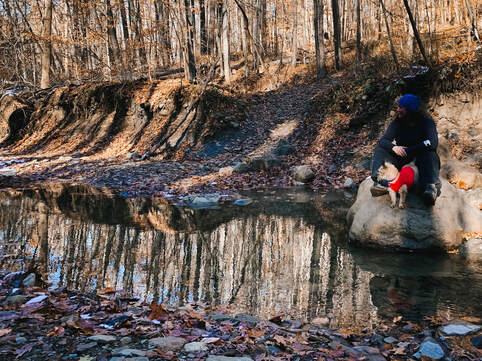 Lucy pondering how McDonalds is life. Lucy pondering how McDonalds is life.
This past weekend, Lucy and I decided to do an adventure of (semi)-epic proportions. So we donned our gear, grabbed some food to take with (McDonalds, don't judge, Lucy has a very refined pallet) and drove down to Cuyahoga Valley National Park to check out a- supposedly- 5.5 mile loop comprised of three separate trails - Perkins, Riding, and Furnace.
But it wasn't 5.5 miles - it was nearly 8. And TOUGH. SURPRISE B! I'm always surprised by what my body is capable of, which apparently is some big ass hills. Read on to get the scoop on the trail and all about our adventure! 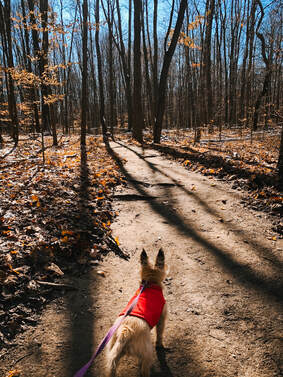 Lucy pondering why there aren't any leaves. Lucy pondering why there aren't any leaves.
The entire trail was beautiful - really lovely - with a lot of changing scenery. If you're up for a good challenge, I'd highly recommend it.
To start, Perkins - just magical, with moss covered trees and glinting light. The weird? SOMEONE CAME THROUGH AND LEAF BLEW THE TRAIL. I was super confused. It made the trail seem weird and unnatural. And privileged in a way that made me uncomfortable. I'll talk more about this in another post. All three trails had a LOT of elevation (three and a half near mountain limits of 1000ft.). The entire trip was basically "up/down up/down." Frankly, I was surprised by how well I held up.
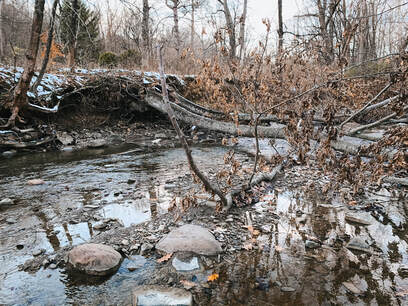 The tree I used as a bridge. The tree I used as a bridge.
After heroically carrying Lucy through the briars, I wasn't going back through it. So I finally found a place to shimmy down. Then I had to cross - which I did by walking across a log. Even in winter, the water was knee high. I'm guessing even less passable in Spring.
I'm sure the rest of Furnace was pretty, though by the time I got through the creek I was beat, dusk was falling, and I still had 2 miles to go....SURPRISE....as I was already at 5 miles.
The last 1/2 mile of Furnace was comprised of dozens of stairs. Not great.
Wrap-Up: It was a real challenge, mainly due to the elevation and the distance I hadn't planned on. I felt *really* good about it at the end - my back held up with the pack. I'd definitely do Perkins and Riding again, but would dodge Furnace. Have you ever been surprised by the length of a hike? Or a trail "disappearing"? Comment below or contact me here.
0 Comments
This is a follow-up to the post I did last week on Vitamin I(buprofen), cause pain and inflammation sucks. From sore backs to tension headaches, nothing puts you down harder or faster than uncontrolled pain. So how the heck do you deal with it when you can't- or don't want to - take NSAIDS? Unsurprisingly, there's a bunch of methods to deal with inflammation and pain, you just have to find what works for you! Below are some of the tricks I, personally, use. Anti-Inflammatory Support
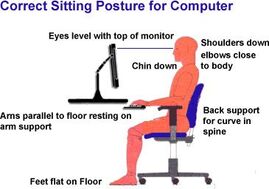 Correct sitting posture, DM for Pic Credit. Correct sitting posture, DM for Pic Credit.
Honorable Mentions for Area Specific Issues
This is just what I've come across that has worked for me. I'm not a doctor or medical provider, and I do recommend you speak with them before starting any kind of supplement or making any significant change. And don't be afraid to do your own research! Most importantly, know there's nothing wrong with you. You haven't failed and you are deserving of whatever adventure you want to chase. How do you deal with pain/inflammation without NSAIDS? Comment below or email me here!  Believe it or not, it's a thing. And it's on Amazon. Believe it or not, it's a thing. And it's on Amazon.
Did you know that Thanksgiving is also the National Day of Mourning?
For most, it's a day to give thanks, to be with family, and to take a minute amid the hustle and bustle. Kids in grade schools dress up as Native Americans and Puritans, sitting down to a "feast" at their school, celebrating the coexistence of Native Americans or how they "saved" their white English buddies. But that's not how it is for everyone, and it doesn't hurt to recognize revisionist, Eurocentric history presented to us in grade school and acknowledge the history behind the day. For many Native Americans, it's the National Day of Mourning....a day to "reflect on the spirituality of their people and to remember those who were persecuted and murdered. It is also a day to protest the oppression and racism that Native American peoples continue to experience to this very day." In fact, it was to give thanks at the murder in 1637 of nearly a 1000 Pequot Native Americans during the Pequot uprising in New England. Governor of Massachusetts Bay Colony declared: “A day of Thanksgiving, thanking God that they had eliminated over 700 men, women and children.” It was signed into law that, “This day forth shall be a day of celebration and thanksgiving for subduing the Pequots.” To the people that say get over it, move on, it was a long time ago. Be quiet and eat your turkey leg. Let me throw this out there - think of some of the other large-scale attacks in American history. Now picture if history remembered it as fact that terrorist/shooter/etc. x and their victims not only helped one another, but were friends. That the event didn't happen as you remember it. How it *should* be remembered. So give thanks and enjoy the day with your family, but don't do it under the guise of something it's not. You can be thankful and enjoy your family, but you don't need the fake-ass story or "injun" paraphernalia (coloring books, cut-out "indian headdresses," the Native American salt & pepper shakers, etc.) to do it. And if you have kids, look at it as the chance to change the way you talk to them about history and correct misunderstandings about history/Thanksgiving in general. American Indians in Children's Literature (AICL) has some recommendations on age-appropriate books from the Native American perspective that can be found here. Highly recommend the list. Most of all, though, be respectful of the fact that not everyone is going to be celebrating. Because it's not over for indigenous peoples - they are still marginalized, their voices unheard, and treaties ignored. Just look at the Keystone Oil Spill. It's not about being perfect, but it's about recognizing injustices for what they are and not ignoring them because it's inconvenient. For my own part going forward, whenever I post pics of an area I hiked, I'm going to try and include what Native American tribes were the original stewards of the land. Because people, and their stories, matter. And that we remember matters. What will you incorporate or change going forward? Comment below or email me here.
"Lots and lots of Vitamin I," a guy replied (laughing) to me the other day, while we were chatting at the physical therapist's office, after I'd queried how he kept up his really intense workout regime with the type of injury he had.
Inwardly, I cringed. Bigly. What's Vitamin I? It's what outdoor folks (particularly thru hikers and hikers) fondly call Ibuprofen, an NSAID, and it's no joke. What's an NSAID? It's a lovely anti-inflammatory drug you can buy over the counter at any pharmacy - it's great for pain and marvelous for inflammation. It's not a steroid and you can buy it everywhere, so it's safe, right? Wrong. When my back injury occurred, the docs started me on large doses of Vitamin I, which I was on for weeks - which totally destroyed my stomach. As in I can't eat the same way I used to, I have a lot of pain with it, and I have had to change how I do things because of it. It's greatly affected my everyday life. There's been a lot of studies, and you can read an overview of them at Time, the Cleveland Clinic, the Mayo Clinic, and Harvard's websites. So what are the risks of NSAIDS? - The heart - increased risk for heart attack by 1/3 (though Ibuprofen more than doubled those risks).....and 19% increased risk of being hospitalized for heart failure - intestinal bleeding - increase chance of stroke - increase change of hearing loss (by 10%) - greater chance of bone loss with resistance training But you only take them occasionally in low doses, so that's fine, right? Nope. You can mess your heart up only using it for less than a week - though long-term use and higher doses increase the risk. Even scarier - they don't know why it increases the risk of a heart event. WTAF. Sometimes, you may *have* to take it, to get some sleep, especially if you manage chronic pain. Don't feel bad about it!! - take the lowest dose possible - don't take more than one kind of NSAID at a time, it increases the danger What if you have chronic, painful inflammation and don't want to take "Vitamin I" any longer? Look for my post next week, where I'll write about some of the wonderful alternatives out there to help deal with inflammation. Because being in pain sucks, and it keeps you from doing the &^%$ you want to do. Do you use NSAIDS? Any problems? How do you deal with pain from activities? Comment below or email me here. 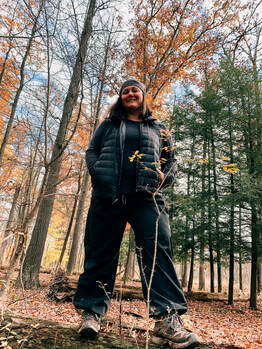 Me in my Talusphere on my birthday hike. Me in my Talusphere on my birthday hike.
One of my work friends (hi Jenny!) asked me the other day if I'm doing anything different now that the cold weather has descended upon us. Short answer, yes. I love the cold weather, and the fact the landscapes look like an apocalyptic wasteland (original Red Dawn anyone?) only adds to the fun. However, my legs and thighs, in particular, get cold in all the wind we get here in Cleveland....these would be great for under garb at LARPS, too. So I went and found myself the REI Co-op Talusphere Pants. In a nutshell? They're great. If you want a pair of shell pants that protect from moisture and wind, at a reasonable price, this is them, so go by them at REI. There are a couple of downsides, especially if you're short and fat, like me. If you want the full scoop, read on!
The Price Tag: $89.50
There's some things I really love about the Talusphere pants - they're made from polyester and they have some significant stretch so I can move freely, which I appreciate for scrambling. You can cinch the ankles tight, and it's waterproof, but by some dark magic also breathable. I haven't turned in to a sweaty mess yet. And I love that the pockets have zippers. They come in a whole range of sizes and shapes, both for men and women.
There are two main downsides to these bad boys. First, the sizing. I don't know what's going on at REI, but it was crazy trying to deal with the sizing on these. The women's goes up to an XL (little small for an XL) and the women's "plus size" goes up to 3X. The problem with the women's larger-sized Talusphere is that they don't come in petite unlike the S-XL. Well......I'm short and fat. Awwwwwkward. If you want to purchase the larger sizes at REI, be aware you must search for "plus-size talusphere women plants." Yes, they're in a totally different section on the website. When I went in to the store, I explained to the very kind helper that I was short and fat (as mentioned above), and she very happily hung out and tried to help me find the right pants. The men's hips didn't fit, even though they get ALL kinds of inseam options for leg length to waist-size. I finally had to settle on the 2X Talusphere Women's Pant. You can see from the way they bunch at the ankles they're significantly too big, but I can move freely in them and I can put a lot of layers on underneath if I want. My biggest complaint is the length of the leg, and would be great if REI added some petite options in the larger lady sizes. My only other complaint, and it's echoed by the reviews on the REI website, is the draw-string waist. It's very thin, and the toggle that holds it in place doesn't work the best, but I just tie a small knot. I haven't had any issues with my pants sagging down, but I have a booty. If you don't, beware! In the end, I'm very happy with the purchase and they've held up great on the trail so far! What winter "shell" pants do you use? (If any) What do you love/hate about them? Feel free to comment or contact me here.
Today is Veteran's Day. It's a day to thank those that have served and defended our country.
Having a degree in history and being particularly drawn to the stories of the past, I've read a lot about the difficulties so many veterans have after being discharged and they return to civilian life. The outdoor world has helped many veterans make the transition a bit easier, put them in touch with other veterans, and when needed given them adaptive access to the outdoors. The outdoors can help on the road to recovery, both mentally and physically. To honor those veterans today, I've put together a few outdoor resources that are available for veterans - some include families in the activities and some are free. There are many, many more that features all kinds of sports and outdoor activities. Thank you, Veterans, for your service. Outdoor Adventures Hope For The Warriors’ Outdoor Adventures Program provides adaptive opportunities for wounded heroes to participate in sporting activities in the great outdoors. Service members, who previously embraced an outdoorsman lifestyle, as well as those new to traditional outdoor sports, are introduced to recreational opportunities on the road to recovery. Warrior Expeditions Warrior Expeditions provides veterans with everything they need to complete a long distance outdoor expedition at no cost to the veteran. Camp Patriot Located in Northwest Montana this first-a-kind 90+ acre facility is a “living monument” to wounded and disabled veterans of all generations. The ranch allows us to offer a host of truly unique outdoor recreational therapy programs. Veterans Trek The mission of Veterans Trek is to provide healthy outdoor and educational activities that allow the restorative powers of nature and Veteran peer support. Our nature-based programs provide both outdoor treks as well as employment and career options for Veterans seeking meaningful work in the natural environment. Outward Bound For Veterans Outward Bound for Veterans helps thousands of returning service members and recent veterans readjust to life at home through powerful wilderness courses that draw on the healing benefit of teamwork and challenge through use of the natural world. SUDS (Soldiers Undertaking Disabled Scuba) The SUDS program is for service members wounded, ill and injured with a permanent physical disability requiring adaptation. The scuba training offered to the service members is a challenging and rewarding activity which can help facilitate the rehabilitation process and offers them an activity that they can enjoy for years to come. Have another resource for Veterans? Comment below, or feel free to contact me here!
One of the big problems getting started with outside adventuring has to do with access. Beginning hikers and walkers can find it difficult to determine if a trail they find online is appropriate to their ability, if they can even find trails around them. Once they find a trail, they want to know what the terrain is like and if there are any obstacles. Are trail bikes welcome? Horses? What about finding the trailhead? Navigating the trail? Any special wildlife areas they should be aware of, like bat habitats? Is it safe for their therapy or service animal?
I've had a number of folks the last few weeks ask what I use to gain access to the outside world, and my go to right now is AllTrails. Hands down, this is the best app I've found to give beginners - and experienced hikers - the access and information they need to get out in the outdoors. Six or seven years ago, I got lost on a Cleveland, OH trail. I had a printed map of the park, but the trails in the Metroparks aren't very well marked in most cases. It was cold and snowing. I had no cell reception and it was getting dark - of course I hadn't brought a headlamp/flashlight. The parks aren't all that big, so I knew I'd eventually find my way out. An hour after dark, my dog Charlie Chuckles and I made it back to the car. I was tired and reallllly pissed off. 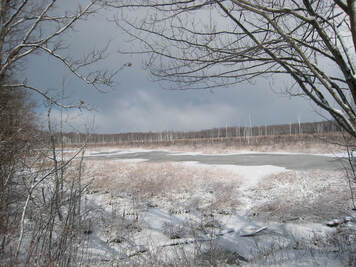 It was really, REALLY cold. It was really, REALLY cold.
And this wasn't the first time I'd gotten turned around on the notoriously ill-marked trails in the Cleveland area. Or been unable to find a trailhead with sketchy directions from the internet. Then came AllTrails. Queue rescue-themed music. AllTrails has been wonderful, and really opened up my access to trails in the Cleveland, OH and surrounding areas. Trails I doubt I would have found, or had the courage to try, without it. AllTrails is awesome - You can select what you want out of a trail and search for it - distance from your home, dogs allowed, length of hike, trail bike accessibility, difficulty, etc. This makes it a great tool for folks with disabilities that need to know if a trail is paved, if there are amenities at the trail head, etc. A nice bonus is that you're able to read reviews and see pics of the trail - great way to check for mud or other problems like downed trees/washed out trails. And it's free. Hiking and outdoor adventuring is already prohibitively expensive for many, and anything that removes additional spending is great (pro-version is $2.50 a month, and gives you access to download/print different topo maps). You can use it to track yourself AND record your hike while on the trail, even when your phone is in airplane mode. AllTrails also has a directions option that will open your phone's GPS app and take you right to the trail head. This is A-mazing. Previously, I found myself constantly lost on back roads, and a few times I even gave up on the hike. As a new hiker finding remote trailheads was incredibly frustrating. It helps build confidence, since you can view nearly all the trails immediately around you, allowing you to add/shorten your hike as you want or need to.
There are a couple downsides to AllTrails to keep in mind - it's not always 100% accurate in regards to length of the trail. I find the trails are often a half mile to a mile longer than indicated.
Keep in mind the difficulty rating of the trail tends to vary wildly. I did a 9 mile moderate trail last weekend, which was, to my surprise, easily and quickly accomplished even though it was pouring rain and I had to take a lot of breaks. Whereas I did a trail a few months ago that was five miles and very hilly, difficult terrain. Both were rated as moderate. I always encourage folks to have a printed map with them as well, and to understand how to read it, especially if you're in larger parks/national forests. Despite these issues, I recommend AllTrails for the access it provides. Have you ever gotten lost on the trail? Do you use an app or stick with a map, or both? Comment below, or feel free to contact me here! I'm sure many of you have seen the viral video of Amy Cooper calling the police on Christian Cooper, an African American bird-watcher who was enjoying the Bramble in New York earlier this week. She called the police because he asked her to put her dog on a leash (park rules). She says in the video, "I'm going to tell them there's an African American man threatening my life." She tried to use this man's race as a weapon against him. The outdoors is political, don't let anyone ever tell you otherwise. When I first googled top 25 hiking blogs of 2019, I was really surprised. The first several sites that listed blogs included very few women and I didn’t visually identify (or see in the descriptions) any minorities. Or people with disabilities. Or Pride Pack members. Or fat people. Everyone looked very, very white. I taught Diversity in America for quite a few years at several local colleges. I don't know why I was surprised at the lack of diversity in the online presence for outdoor adventures in the U.S., since there's a definitive lack of representation on trails. When my friend told some co-workers he was going backpacking for the weekend, his African-American buddy responded along the lines of, “Only in America would white people go in to the woods and pretend to be homeless.” It bothered me on a level that was difficult for me to define, because I view the outdoors as such an important part of who I am. It's a privilege. And privilege and access is a big part of the problem - because it isn't that way for everyone. The Outdoor Foundation, who conducted a survey in 2013, found that 73% of participants in outdoor activities were white, and 47% had an income above $75K (You can read the entire report on their website here.). And when whites in the U.S., on average, are the ones making that higher income, it's indicative of a problem and not just in relation to getting folks in to the great outdoors. Who's involved matters, too - from how outdoor events and activities are marketed to who runs the parks programs, you'll see primarily white people. The Green 2.0 Report demonstrates a clear lack of diversity in the government agencies, foundations, and NGOs that oversee outdoors recreation and upkeep: The world is a changing place, and it’s time for more outdoor activities, and the folks that are already involved in those activities, to change with it.
Race and ethnic minorities made up 40% of the U.S. population in 2016, and those numbers continue to increase. Consider the words of Teresa Baker, a contributor for The Bold Italic, when she wrote “The climate is changing, and so are the demographics of our country. What will happen when, in two to three decades, our new, non-white majority in the US doesn’t care about the environment due to a lack of involvement now?” While I fit the definition of a Misfit Hiker & Adventurer for a number of reasons, I am, in fact, white. So I come at this, clearly, from a very different perspective. I'd like to note that I am not here to define for anyone else what experiences they should have in the outdoor world or how they should feel about those experiences and/or interactions. However, what I can do, is try to make those outdoor spaces more welcoming. I can conduct and relate research in to different issues. And I can showcase others opinions, viewpoints, and experiences. Misfit Hikers is about inclusion and representation, and you're going to find a lot of emphasis on how people access (or don't access) the outside world of adventuring. And what actions can be taken to address identified issues. As a former teacher, I'm a big fan of education and considering other viewpoints - it forges a connection and helps shape how we view the world (and others). My very small first action is to start gathering resources on different topics regarding inclusion and representation in the outdoors. You can find the start of my efforts here. If you know of an article, website, Instagram, etc. that you'd like to see included, please comment! Or feel free to email me. What happened to Christian Cooper shouldn't ever happen. As stewards of the outdoors we need to - have to - do better. I need to be kind to my body. I have to remind myself of this more often than I care to admit. I often get frustrated by my limitations when I'm in the outside world. I want to hike further, explore new and more remote areas, and climb technically difficult summits.
And I can't always do that. It's my back injury. I know that if I push too far, go too far, I'm going to end up in a lot of pain and unable to get back out there for weeks, maybe even months. And that's definitely not worth it. I have to do things differently. I have to use lighter equipment. I have to make sure my boots have the right support. That my pack doesn't press in to certain areas of my back - 52 packs later and I finally found one! I have to take breaks and do stretches throughout hikes, even shorter ones. I need to remember that high mileage hikes two days in a row may be a problem. Heck, even hiking two days in a row may cause a problem. In other words - I need to be kind to my body. Despite my frustrations, I need to remember to thank my body for what it CAN do. It CAN go on hikes, and take me to places I haven't seen, deep in to forests. And that there are people with able bodies that will never see the hidden, secret places I will. And while I may have to take it slow and easy, that's just part of what makes it my journey. So happy birthday to me - and my body. And remember, be kind to yourself and your body. Do you ever get frustrated with the limitations of your body? What do you do? Leave a comment below or contact me here! |
Archives
March 2021
Categories
All
|
